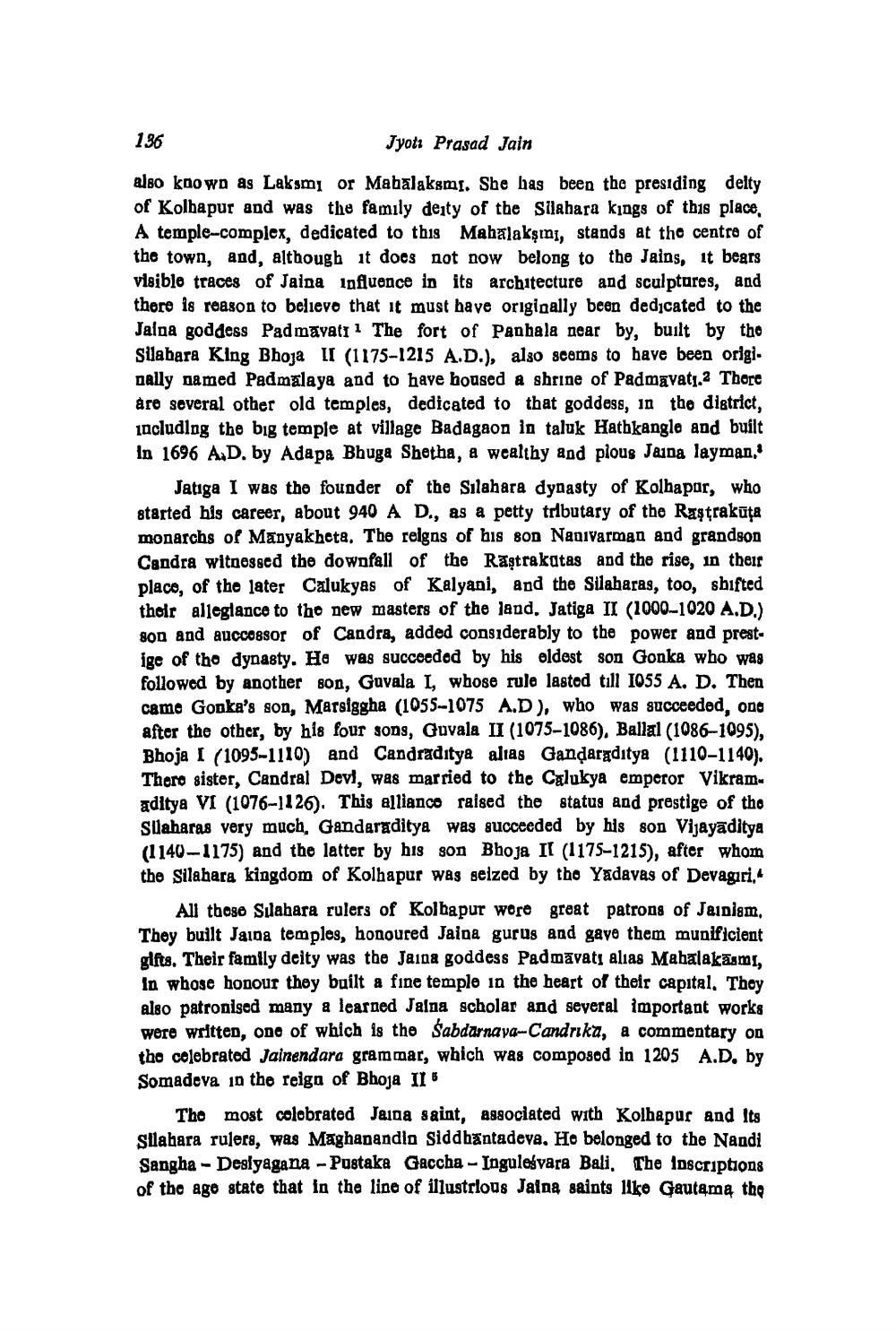________________
136
Jyoti Prasad Jain
also known as Laksmi or Mahalaksmi. She has been the presiding deity of Kolhapur and was the family deity of the Silahara kings of this place, A temple-complex, dedicated to this Mahalaksmi, stands at the centre of the town, and, although it does not now belong to the Jains, it bears visible traces of Jaina influence in its architecture and sculptures, and there is reason to believe that it must have originally been dedicated to the Jaina goddess Padmavati1 The fort of Panhala near by, built by the Silabara King Bhoja II (1175-1215 A.D.), also seems to have been origi. nally named Padmalaya and to have housed a shrine of Padmavati.2 There àre several other old temples, dedicated to that goddess, in the district, including the big temple at village Badagaon in taluk Hathkangle and built In 1696 A.D. by Adapa Bhuga Shetha, a wealthy and plous Jaina layman,'
Jatiga I was the founder of the Silahara dynasty of Kolhapur, who started his career, about 940 A D., as a petty tributary of the Raṣṭrakūta monarchs of Manyakheta. The reigns of his son Nanivarman and grandson Candra witnessed the downfall of the Rastrakutas and the rise, in their place, of the later Calukyas of Kalyani, and the Silaharas, too, shifted their allegiance to the new masters of the land. Jatiga II (1000-1020 A.D.) son and auccessor of Candra, added considerably to the power and prestige of the dynasty. He was succeeded by his eldest son Gonka who was followed by another son, Guvala I, whose rule lasted till 1055 A. D. Then came Gonka's son, Marsiggha (1055-1075 A.D), who was succeeded, one after the other, by his four sons, Guvala II (1075-1086), Ballal (1086-1095), Bhoja I (1095-1110) and Candraditya alias Ganḍaraditya (1110-1140). There sister, Candral Devi, was married to the Calukya emperor Vikramaditya VI (1076-1126). This alliance raised the status and prestige of the Silaharas very much, Gandaraditya was succeeded by his son Vijayaditya (1140-1175) and the latter by his son Bhoja II (1175-1215), after whom the Silahara kingdom of Kolhapur was seized by the Yadavas of Devagiri,
All these Silahara rulers of Kolhapur were great patrons of Jainism, They built Jaina temples, honoured Jaina gurus and gave them munificient gifts. Their family deity was the Jaina goddess Padmavati alias Mahalakāsmi, In whose honour they built a fine temple in the heart of their capital. They also patronised many a learned Jalna scholar and several important works were written, one of which is the Sabdarnava-Candrika, a commentary on the celebrated Jainendara grammar, which was composed in 1205 A.D. by Somadeva in the reign of Bhoja II"
The most celebrated Jaina saint, associated with Kolhapur and its Silahara rulers, was Maghanandia Siddhantadeva. He belonged to the Nandi Sangha - Deslyagana - Pustaka Gaccha - Inguleśvara Bali. The inscriptions of the age state that in the line of illustrious Jaina saints like Gautama the




